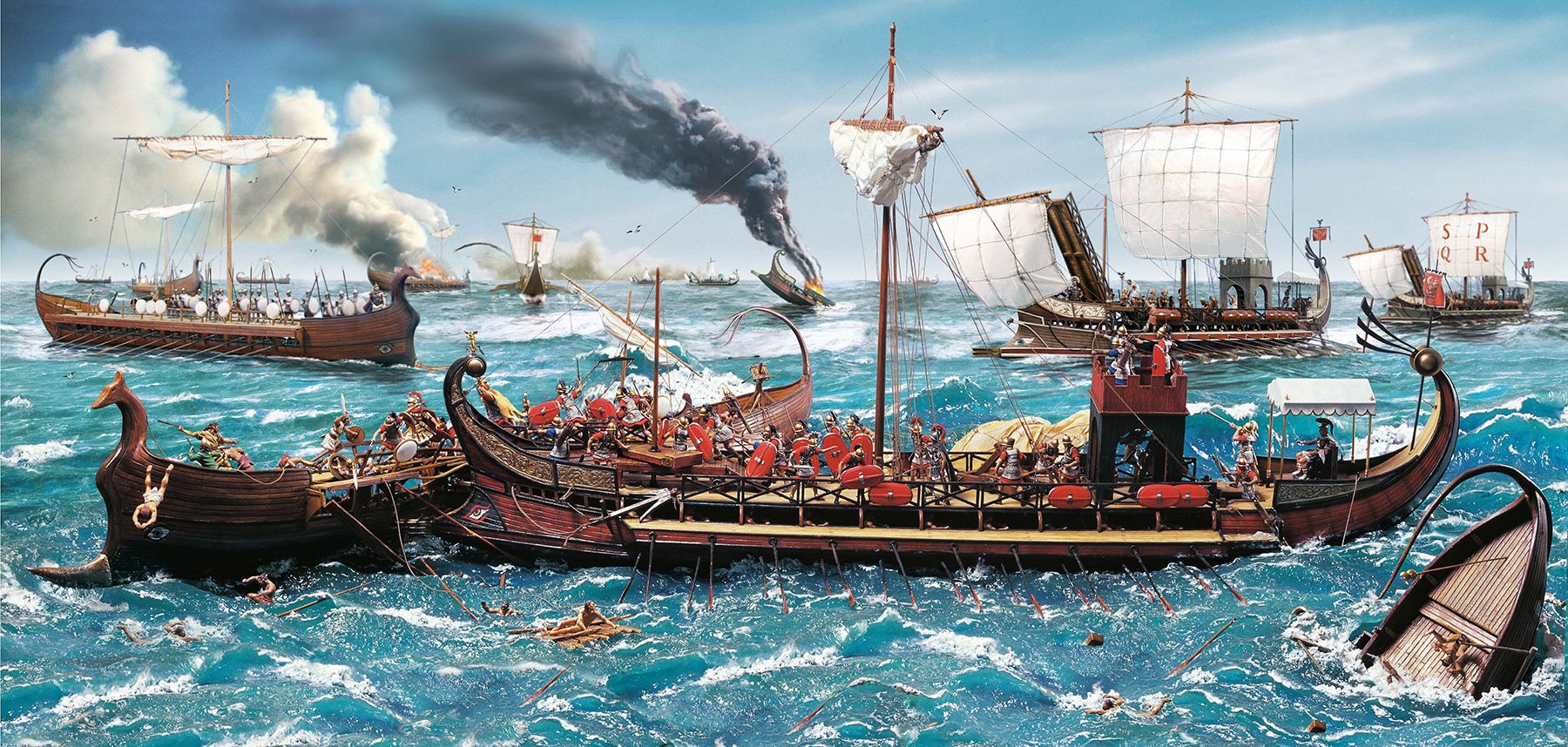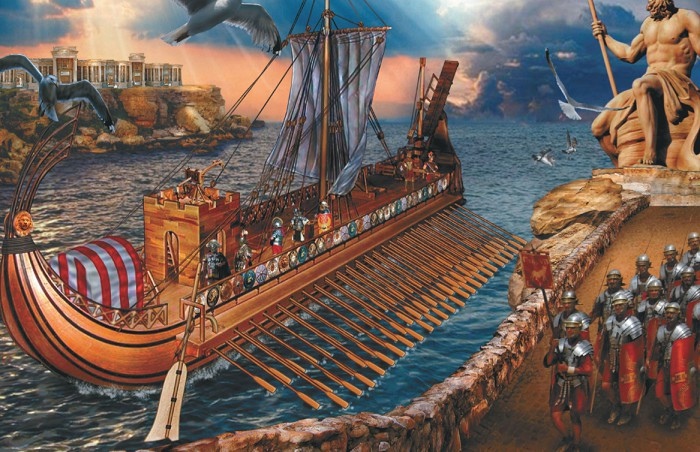Origins of the Roman Navy
The Early Years: Maritime Trade and Piracy (509-264 BCE)

The origins of the Roman navy date back to the 6th century BCE, when Rome was still a small city-state struggling for power in central Italy. At that time, the Mediterranean Sea was already a major hub of maritime trade and commerce, with various cities and states competing for control over the sea routes.
The early years of Roman naval development were closely tied to its need to establish itself as a major player in this maritime world. As Rome expanded its territory through the Italian peninsula and beyond, it encountered numerous challenges from pirates, rival city-states, and even other Mediterranean powers like Carthage.
Maritime trade was also becoming increasingly important for Rome’s economy and growth. The city-state needed to secure a steady supply of goods, such as grains, olive oil, and metals, which were essential for its expanding population and military campaigns.
To address these challenges and opportunities, the Romans turned to maritime development and the creation of a navy. Initially, their naval efforts focused on building ships and assembling crews to protect Roman merchant vessels from pirate attacks and rival city-states.
The first recorded mention of a Roman navy is found in ancient sources around 509 BCE, which marks the beginning of the Roman Republic. During this period, the Romans are believed to have constructed a fleet of approximately 100 ships, mostly smaller vessels like corvettes and triremes, designed for coastal defense and piracy suppression.
However, it’s essential to note that the development of the early Roman navy was not an isolated event but rather part of a broader process. Rome’s growth and expansion led to increased competition with other Mediterranean powers, particularly Carthage, which dominated maritime trade in the western Mediterranean at the time.
The interactions between Rome and Carthage played a significant role in shaping the early Roman navy. While initially, Rome focused on defending its merchant ships from pirate attacks, it eventually began to develop a more assertive naval policy aimed at countering Carthaginian dominance.
Between 509 and 264 BCE, the Roman navy underwent several transformations. It expanded its size, adapted its designs to respond to emerging threats, and developed tactics for warfare on the high seas. These efforts ultimately positioned Rome as a significant maritime power in the Mediterranean, preparing it for even greater naval challenges ahead.
As the Roman Republic continued to grow and expand, its navy would play an increasingly crucial role in shaping the course of its history. The experiences gained during this early period of maritime development laid the foundation for the emergence of Rome as a major naval power, one that would eventually dominate the Mediterranean Sea.
The development of the Roman navy began in 509 BCE, when the Roman Republic was formed. Initially, maritime trade played a significant role in Rome’s economy, with the citystate relying on sea routes to import goods from various regions. However, this reliance also created an opportunity for piracy, which posed a threat to Roman commerce and navigation.
The origins of the Roman Navy date back to 509 BCE, when the Roman Republic was formed. This marked the beginning of a new era for Rome’s maritime activities, as the city-state sought to expand its trade and commerce beyond its borders.
In the early days of the Roman Republic, maritime trade played a significant role in Rome’s economy. The city-state relied heavily on sea routes to import goods from various regions, including grains, wine, olive oil, and other essential commodities. This reliance on maritime trade created an opportunity for piracy, which posed a threat to Roman commerce and navigation.
The threat of piracy was particularly pronounced during the 5th century BCE, when the Romans were engaged in extensive trade with various Mediterranean cities and states. Pirate attacks on Roman merchant vessels were common, resulting in significant losses for the city-state’s economy. In response to these challenges, the Romans began to develop their naval capabilities, initially relying on private ships and merchant vessels to counter piracy.
The earliest recorded instance of Roman naval activity dates back to 480 BCE, when a group of private ships was tasked with protecting Roman trade routes from pirate attacks in the Tyrrhenian Sea. Although this early attempt at establishing a Roman Navy was limited in scope, it marked the beginning of Rome’s journey towards becoming a major maritime power.
The development of the Roman Navy continued to progress during the 4th and 3rd centuries BCE, as the city-state expanded its territorial control and began to establish colonies in various parts of Italy. As Rome’s influence grew, so did its need for a powerful navy to protect its trade routes and naval interests.
Here are some key milestones in the development of the Roman Navy:
509 BCE: The formation of the Roman Republic marked the beginning of the Roman Navy’s development. Initially, maritime trade played a significant role in Rome’s economy.
480 BCE: The first recorded instance of Roman naval activity, when private ships were tasked with protecting Roman trade routes from pirate attacks in the Tyrrhenian Sea.
343-341 BCE: The Romans established their first permanent fleet in Sicily, marking a significant milestone in the development of their navy.
264-241 BCE: Rome’s naval war with Carthage marked a turning point in the development of the Roman Navy. The Romans gained valuable experience and expertise in naval warfare during this conflict.
The development of the Roman Navy played a critical role in shaping Rome’s rise to become one of the dominant powers in the Mediterranean region. As the city-state expanded its territorial control, its naval capabilities continued to evolve, ultimately becoming a key factor in Rome’s success as a major maritime power.
The Expansion of the Roman Navy (264-146 BCE)
The Romans’ response to piracy and their growing maritime ambitions led to the formation of a more organized naval force. According to Livy (1.20), in 311 BCE, Rome created its first fleet, comprised of 100 ships, which were used primarily for defensive purposes. However, with the outbreak of the Punic Wars against Carthage, Rome’s navy began to play a more significant role. The Roman Senate authorized the construction of larger warships, and by the time of the Second Punic War (218201 BCE), Rome had established a formidable naval presence in the Mediterranean.
The expansion of the Roman Navy during the 3rd to 2nd centuries BCE was a pivotal moment in the history of Rome, marking a significant shift from a land-based military power to a maritime force capable of projecting power across the Mediterranean.
The Romans’ response to piracy and their growing maritime ambitions led to the formation of a more organized naval force. According to Livy (1.20), in 311 BCE, Rome created its first fleet, comprised of 100 ships, which were used primarily for defensive purposes against the Latins and Etruscans.
However, with the outbreak of the Punic Wars against Carthage, Rome’s navy began to play a more significant role. The Roman Senate authorized the construction of larger warships, known as liburnes and quinqueremes, which were designed for both speed and maneuverability.
The Second Punic War (218-201 BCE) marked a turning point in the development of the Roman Navy. Rome had established a formidable naval presence in the Mediterranean, with a fleet of over 500 ships, including warships, transports, and supply vessels.
The Roman Navy’s expansion during this period was driven by several factors, including the need to transport troops and supplies across the sea, the requirement to blockade enemy ports and disrupt their supply chains, and the desire to establish a strong maritime presence in the Mediterranean.
The Roman Navy’s achievements during the Punic Wars were impressive, with notable victories at Mylae (260 BCE), Ecnomus (256 BCE), and the Battle of the Aegates Islands (241 BCE). These successes established Rome as a dominant naval power in the Mediterranean, paving the way for its further expansion and conquest.
However, despite these achievements, the Roman Navy’s development during this period was not without challenges. The construction of large warships required significant resources, including skilled labor, materials, and financial investments. Additionally, the Roman Navy faced stiff competition from other naval powers in the Mediterranean, including Carthage and Rhodes.
Despite these challenges, the Roman Navy continued to expand and evolve during this period, with significant improvements in ship design, tactics, and logistics. The Roman Navy’s successes during the Punic Wars marked a turning point in the history of Rome, establishing it as a major maritime power capable of projecting its influence across the Mediterranean.
The legacy of the Roman Navy during this period can be seen in its impact on the development of modern navies, with many countries adopting similar designs and tactics. Additionally, the Roman Navy’s achievements in shipbuilding, engineering, and logistics laid the foundation for later technological advancements and innovations.
Consolidation and Innovation (146 BCE – 476 CE)
The Roman navy continued to evolve after the defeat of Carthage. By the late Republic period, Rome’s maritime power was unmatched. The development of advanced shipbuilding techniques, such as the use of corvus boarding bridges, gave the Romans a significant advantage over their opponents. Additionally, the Roman navy played an essential role in maintaining control over its vast territorial empire by enforcing maritime trade and naval blockade policies, as documented by the historian Cassius Dio (Historia Romana 4.21).
The Roman navy underwent significant transformations during the period of Consolidation and Innovation, spanning from 146 BCE to 476 CE. This era saw the rise of Rome’s maritime power, which eventually became unmatched in the region.
Following the defeat of Carthage, the Roman navy continued to evolve and adapt to new challenges. One crucial development was the introduction of advanced shipbuilding techniques, such as the use of corvus boarding bridges. These ingenious structures allowed Roman sailors to board enemy ships with greater ease, significantly enhancing their naval capabilities.
The late Republic period witnessed a remarkable expansion of Rome’s maritime power. The Roman navy played a pivotal role in maintaining control over its vast territorial empire by enforcing maritime trade and naval blockade policies. This strategic approach ensured that the Romans had a firm grip on their dominions, facilitating the exchange of goods, resources, and ideas throughout their empire.
Historian Cassius Dio provides valuable insights into the Roman navy’s activities during this period. In his book Historia Romana (4.21), Dio documents the crucial role of the Roman navy in enforcing maritime trade and naval blockade policies. This not only highlights the navy’s importance but also underscores the significance of its strategic operations.
The corvus boarding bridges, in particular, were a game-changer for the Roman navy. These innovative structures allowed Roman sailors to board enemy ships with greater precision and speed, giving them a significant advantage over their opponents. This marked a new era in naval warfare, where the Romans could now effectively engage and overpower their enemies at sea.
The Roman navy’s advancements during this period also had a profound impact on the broader Roman Empire. By enforcing maritime trade and naval blockade policies, the navy helped to maintain control over Rome’s vast territories, ensuring the continued flow of goods, resources, and ideas throughout the empire.
- Austin, Texas - September 4, 2024
- Country Flags With Stars - September 4, 2024
- 7 Oldest Cities In The United States - September 4, 2024


